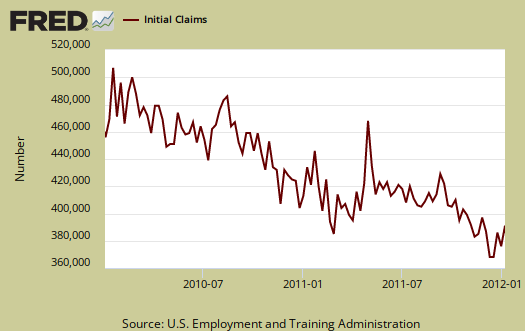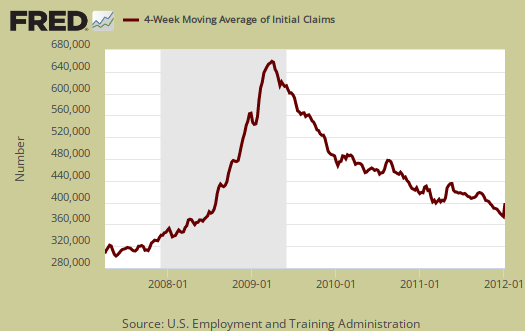Initial weekly unemployment claims for the week ending on January 7th, 2012 were 399,000. The DOL reports this as a increase of 24,000 from last week. The previous week was revised, from 372,000 to 375,000, an increase of 3,000.

This is a sharp uptick, but bear in mind this is the first week after the holiday. The DOL does adjust weekly initial unemployment claims for seasonal increases and decreases, but since the report is issued weekly, there is a lot of variance even with holiday adjustments. For example, we could have a pent up clumping of people waiting to file and be processed by the States due to the holidays. Additionally, companies love to give workers that final Christmas present, being fired right before the start of the new year. Layoffs actually increased from 2010, yet were down -1.6% from November. Yet many companies do not announce layoffs, but quietly shed workers as their yearly profit and loss statements are finalized. Additionally, it seems some employers do not classify jobs as temporary, seasonal when they should be. It seems there was great hope for holiday sales, which did not materialize.
Every week initial unemployment claims are also revised and the above graphs shows this report is noisy. One simply cannot compare the reported numbers on a week to week basis due to the lag in States reporting claims data and revisions, plus the fact this is a 1 week time window, versus a monthly one. One needs to at minimum look at the 4-week moving average, which is also below the magic 400,000 number which shows jobs creation. The 4 week moving average is now 381,750 and increased 7,750 from last week.
Below is the 4 week moving average, set to a logarithmic scale to remove even more statistical noise, for the last year. We have a clear downward trend, which is good news. The initial unemployment report is indicating moderate to modest job growth. Notice in the below graph around the 1st of the year has uptick data point in initial claims.

The magic number to show job creation is at minimum, below 400,000 initial unemployment claims, per week. Most Economists will quote 375,000 as the magic number to indicate job growth.
Below is the mathematical log of initial weekly unemployment claims, so one can get a better sense of the rise and fall of the numbers. A log helps remove some statistical noise, it's kind of an averaging. As we can see we have a step rise during the height of the recession, but then a leveling where every week initial unemployment insurance claims hover around 400,000, refusing to really drop, a never ending labor malaise for most of the time after the recession ended in July 2009. What we need to see here is a steep decline over time.

Below is the 4 week moving average, set to a log scale, from April 1st, 2007. We are nowhere near pre-recession initial weekly unemployment claims levels. Yet we can see how much improved the numbers are. Of course everyone in America should have been fired at least once by now.

Weekly initial unemployment claims are statistically noisy, the numbers are always revised, there is large variance because it's a weekly data report instead of monthly, and only through a long term pattern can one say anything about the unemployment situation. While this report is great news, what we want to see is a strong trend. It will take a few more months before we can declare one.
Continuing unemployment claims dropped but bear in mind people can plain being running out of benefits.
The advance number for seasonally adjusted insured unemployment during the week ending December 31, was 3,628,000, an increase of 19,000 from the preceding week's revised level of 3,609,000. The 4-week moving average was 3,605,000, unchanged from the preceding week's revised average.
In the week ending December 24th, not seasonally adjusted, the raw number was 7,333,213 official people obtaining some sort of unemployment insurance benefit. Officially, there are 13.097 million unemployed and if one takes all of the people who want a job, including those stuck in part-time because they can't get anything else, the number is over 28 million. Even at the December job growth rate, it will take a decade to recover America's jobs.
Here is last week's initial unemployment claims overview, not revised.

Recent comments